Greenhouse Gas Induced Changes in the Seasonal Cycle of the Amazon Basin in Coupled Climate-Vegetation Regional Model
Abstract
:1. Introduction
2. Methodology
2.1 The Coupled Climate Model and the Design of the Numerical Experiment
2.2 Harmonic Analysis
3. Results and Discussion
3.1. Present Day Climate
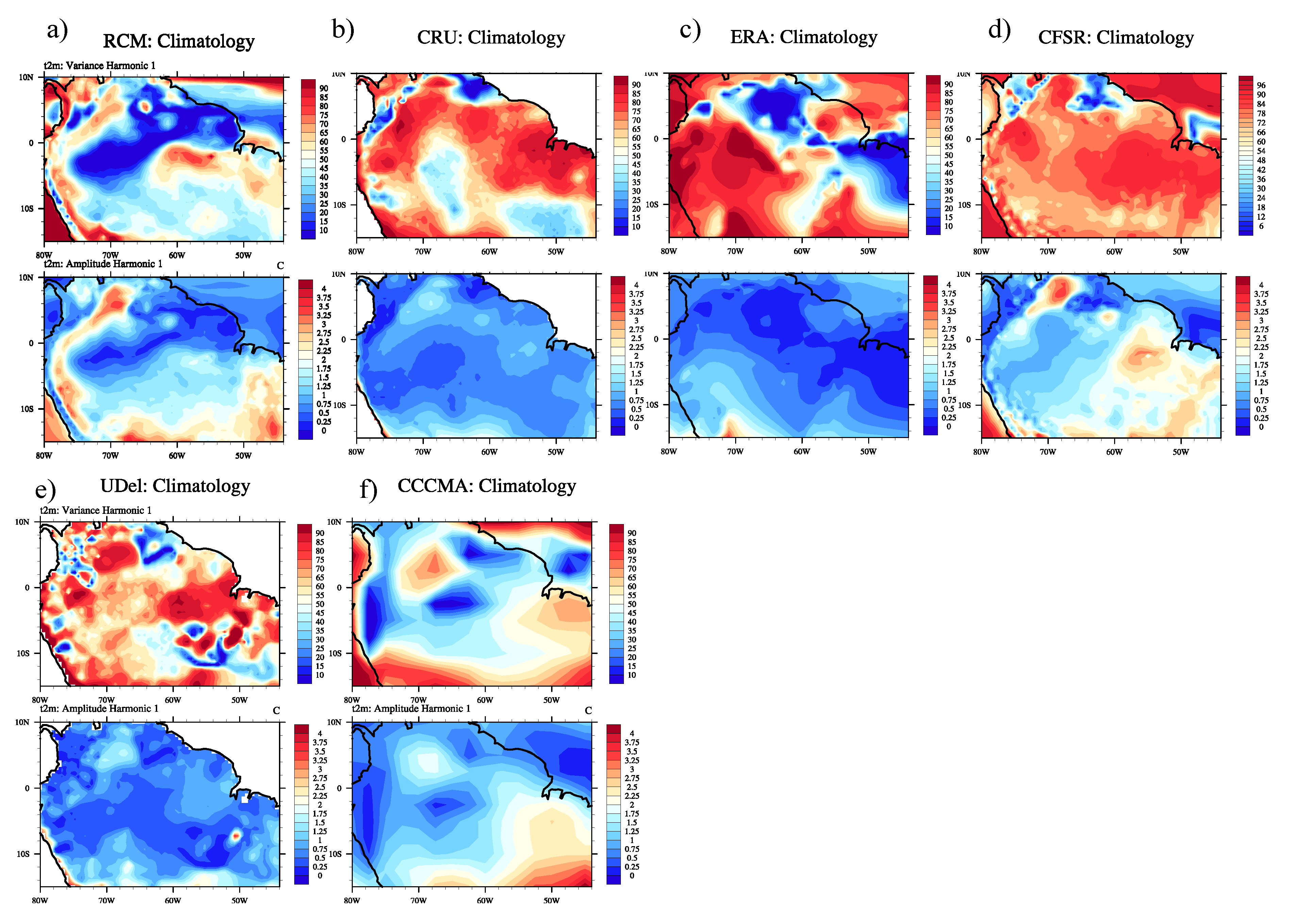
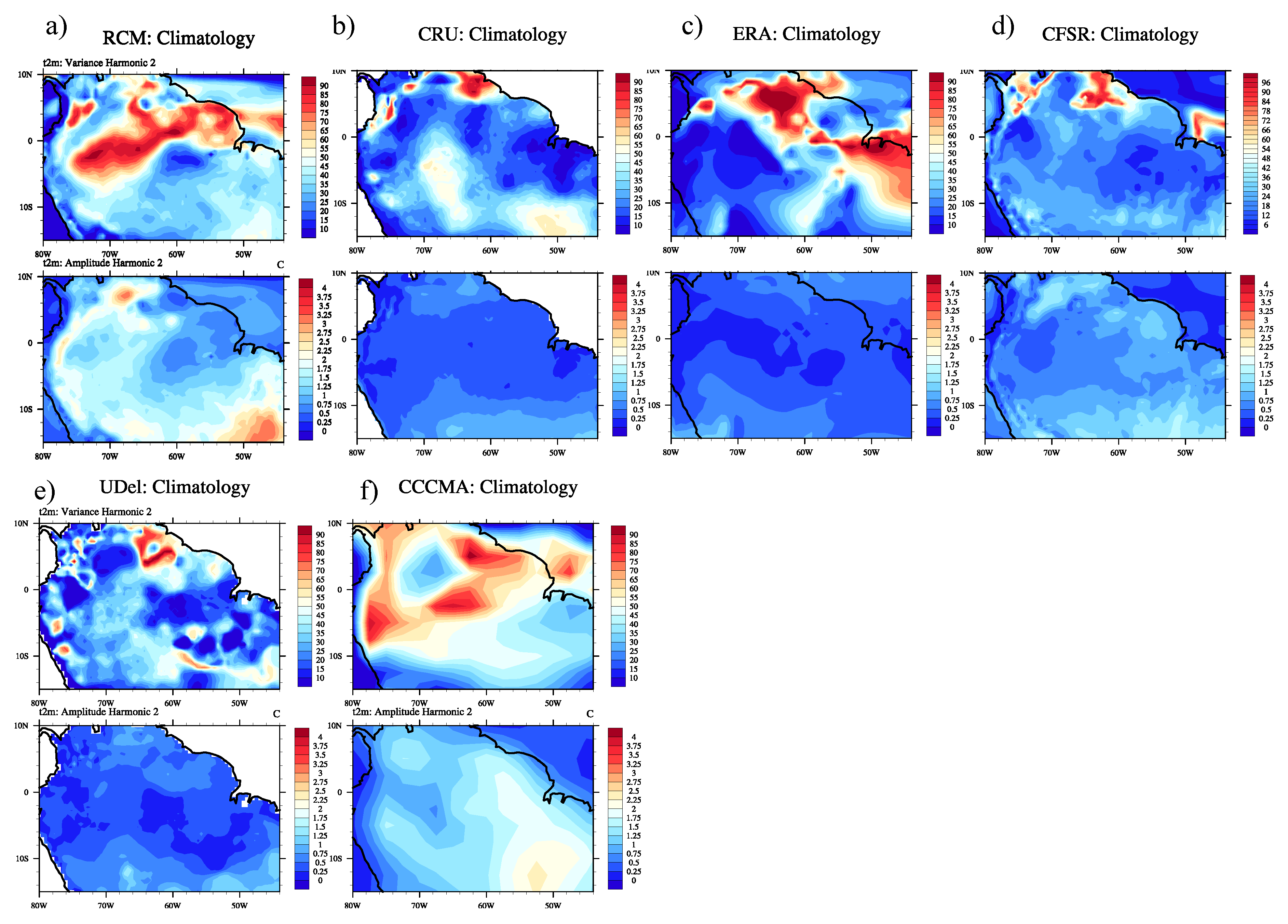
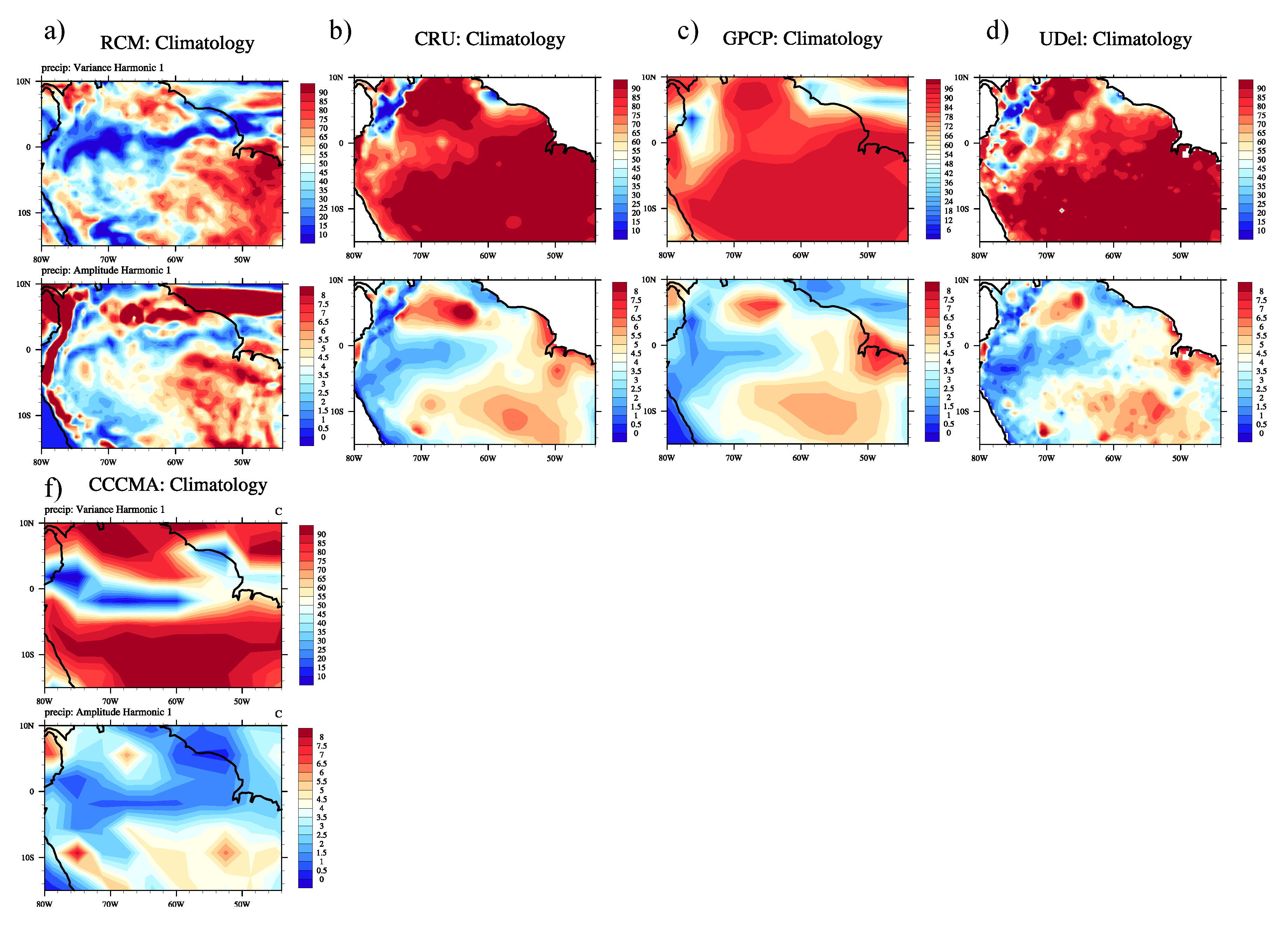
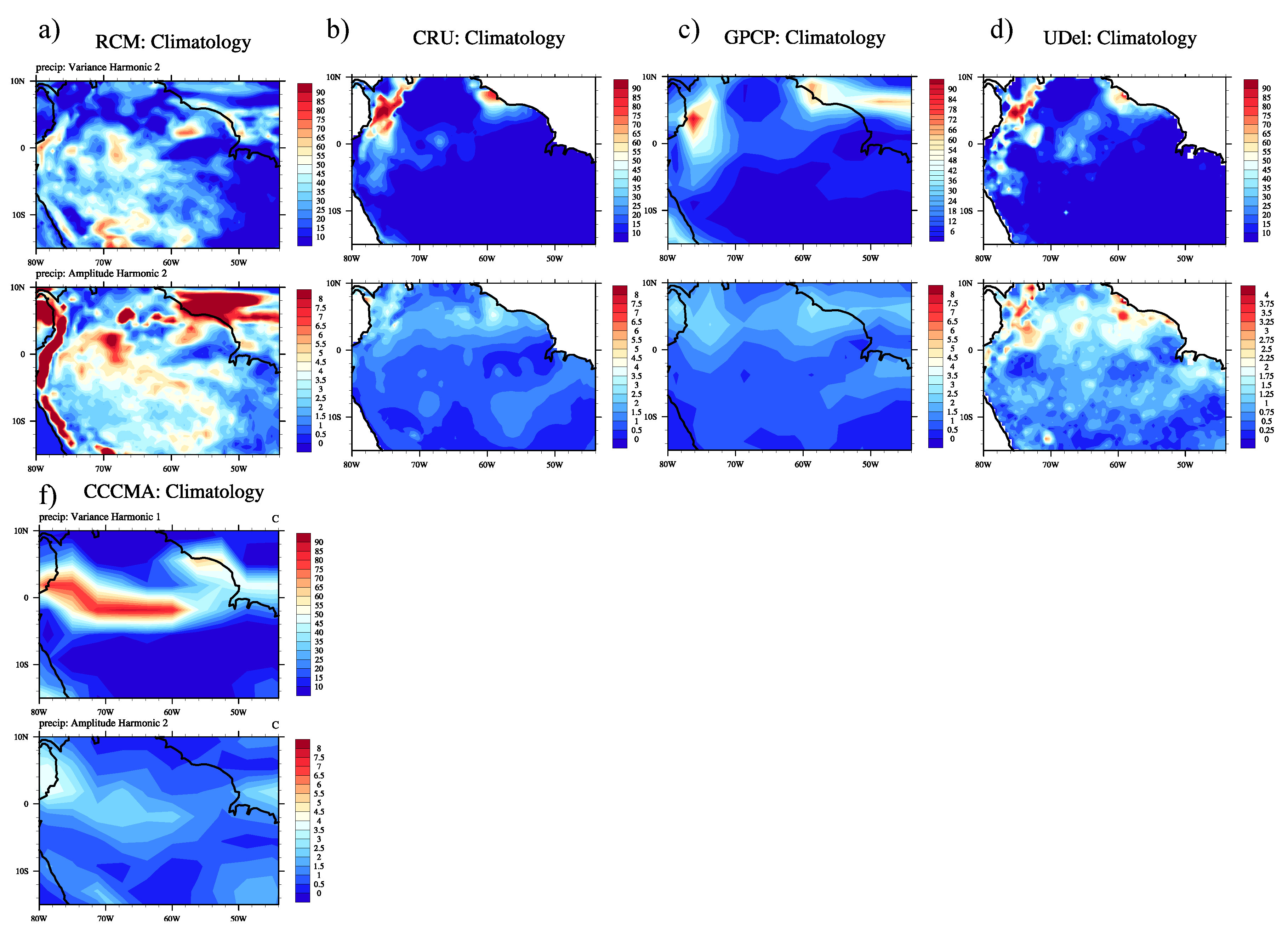
3.2. Greenhouse Warming Climates Anomalies
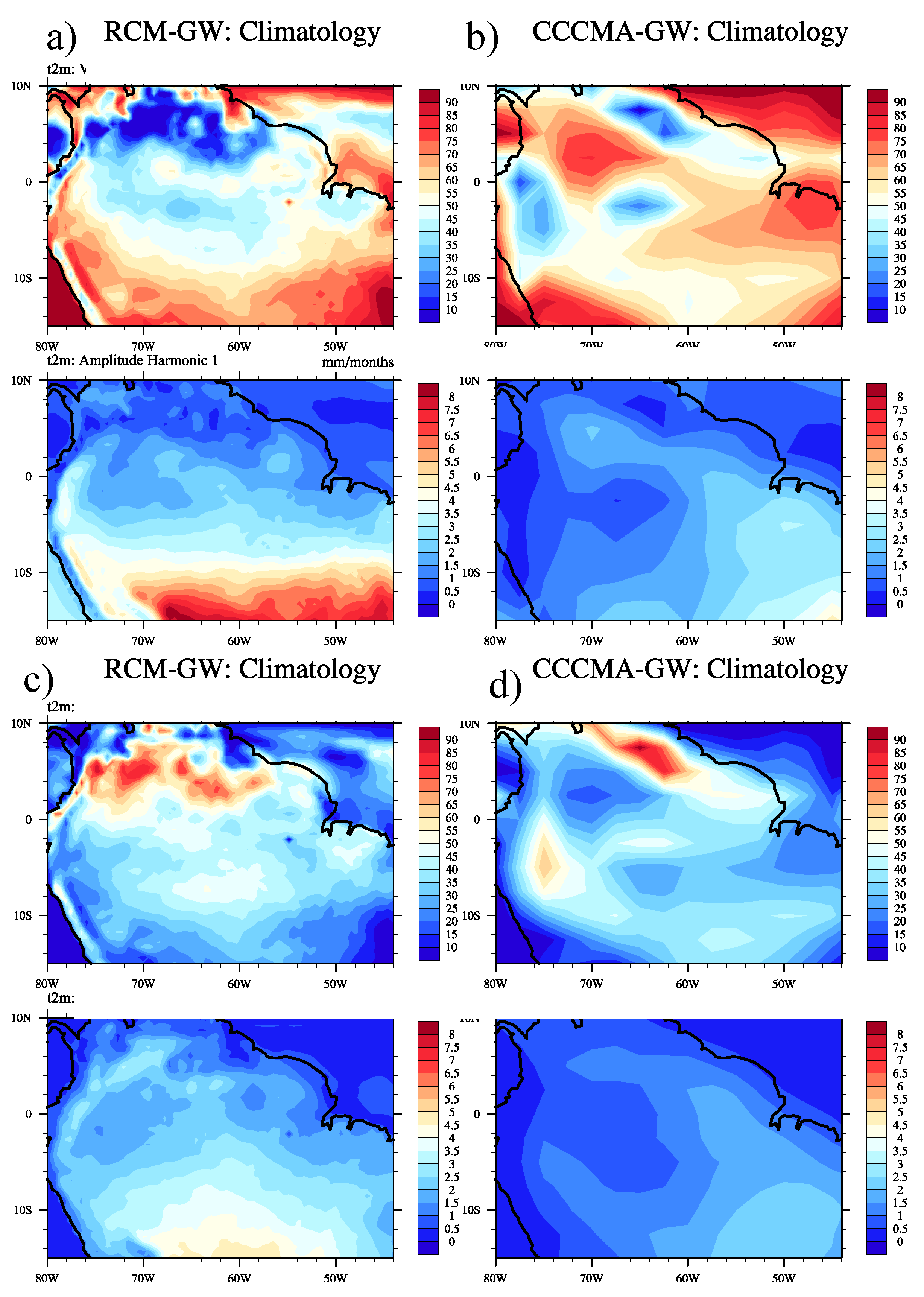
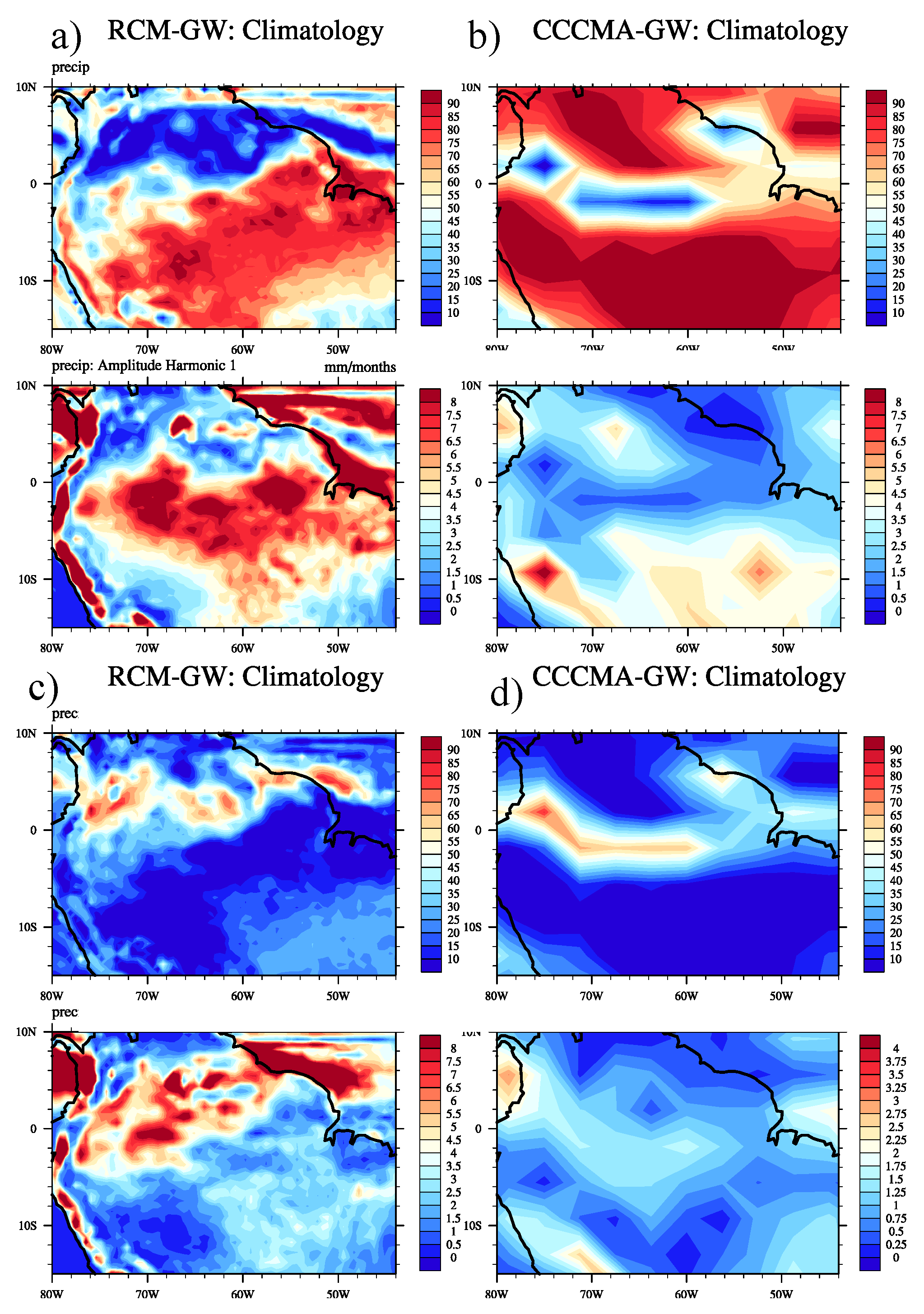
4. Conclusions
Acknowledgments
Author Contributions
Conflicts of Interest
References
- Sellers, W. Potential evapotranspiration in arid regions. J. Clim. 1963, 3, 98–105. [Google Scholar] [CrossRef]
- Kayano, M.T.; Andreoli, R.V. Relations of South American summer rainfall interannual variations with the Pacific Decadal Oscillation. Int. J. Climatol. 2007, 27, 531–540. [Google Scholar] [CrossRef]
- Marengo, J.A.; Nobre, C.A.; Tomasella, J.; Cardoso, M.F.; Oyama, M.D. Hydro-climatic and ecological behavior of the drought of Amazonia in 2005. Philos. Trans. R. Soc. B Biol. Sci. 2008. [Google Scholar] [CrossRef] [PubMed]
- Da Rocha, R.P.; Reboita, M.S.; Dutra, L.M.M.; Llopart, M.P.; Coppola, E. Interannual variability associated with ENSO: Present and future climate projections of RegCM4 for the South America CORDEX domain. Clim. Change 2014. [Google Scholar] [CrossRef]
- Da Rocha, R.P.; Cuadra, S.V.; Reboita, M.S.; Kruger, L.F.; Ambrizzi, T.; Krusche, N. Effects of RegCM3 parametrizations on simulated rainy season over South America. Clim. Res. 2012, 52, 253–265. [Google Scholar] [CrossRef]
- Solman, S.A.; Sanchez, E.; Samuelsson, P.; da Rocha, R.P.; Li, L.; Marengo, J.; Pessacg, N.L.; Remedio, A.R.C.; Chou, S.C.; Berbery, H.; et al. Evaluation of an ensemble of regional climate model simulations over South America driven by the ERA-Interim reanalysis: model performance and uncertainties. Clim. Dyn. 2013. [Google Scholar] [CrossRef]
- Cook, K.; Vizy, E.K. Effects of twenty-first-century climate change on the Amazon rainforest. J. Clim. 2008, 21, 542–560. [Google Scholar] [CrossRef]
- Huntingford, C.; Zelazowski, P.; Galbraith, D.; Mercado, L.M.; Sitch, S.; Fisher, R.; Lomas, M.; Walker, A.P.; Jones, C.D.; Booth, B.B.B.; et al. Simulated resilience of tropical rainforests to CO2-induced climate change. Nat. Geosci. 2013, 6, 268–273. [Google Scholar]
- Rammig, A.; Jupp, T.; Thonicke, K.; Tietjen, B.; Heinke, J.; Ostberg, S.; Lucht, W.; Cramer, W.; Cox, P. Estimating the risk of Amazonian forest dieback. New Phytol. 2010, 187, 694–706. [Google Scholar] [CrossRef] [PubMed]
- Oyama, M.D.; Nobre, C.A. A simple potential vegetation model for coupling with the Simple Biosphere Model. Braz. J. Meteorol. 2004, 19, 204–216. [Google Scholar]
- Gentry, A.H.; Lopez-Parodi, J. Deforestation and increased floods of the upper Amazon. Science 1980. [Google Scholar] [CrossRef] [PubMed]
- Giorgi, F.; Coppola, E.; Raffaele, F.; Diro, G.T.; Fuentes-Franco, R.; Giuliani, G.; Mamgain, A.; Llopart, M.P.; Mariotti, L.; Torm, C. Changes in extremes and hydroclimatic regimes in the CREMA ensemble projections. Clima. Change 2014. [Google Scholar] [CrossRef]
- Coppola, E.; Giorgi, F.; Raffaele, F.; Fuentes-Franco, R.; Giuliani, G.; LLopart-Pereira, M.; Mamgain, A.; Mariotti, L.; Tefera Diro, G.; Torma, C. Present and future climatologies in the Phase I CREMA experiment. Clim. Change 2014, 125, 23–38. [Google Scholar] [CrossRef]
- Francis, F.W.S.; Alvalá, R.C.S.; Manzi, A.O. Modeling the impacts of land cover change in Amazonia: A regional climate model (RCM) simulation study. Theor. Appl. Climatol. 2008, 12, 225–244. [Google Scholar]
- Llopart, M.; da Rocha, R.P.; Cuadra, S.V.; Coppola, E.; Giorgi, F. Land surface feedbacks and climate change over South America as projected by RegCM4. Clim. Change 2014, 125, 111–125. [Google Scholar] [CrossRef]
- Werth, D.; Avissar, R. The Regional evapotranspiration of the Amazon. J. Hydrometeorol. 2004, 5, 100–109. [Google Scholar] [CrossRef]
- Hutyra, L.R.; Munger, J.W.; Nobre, C.A.; Saleska, S.R.; Vieira, S.A.; Wofsky, S.C. Climatic variability and vegetation vulnerability in Amazônia. Geophys. Res. Lett. 2005, 32, L24712. [Google Scholar] [CrossRef]
- Andreae, M.O.; Rosenfeld, D.; Artaxo, P.; Costa, A.; Frank, G.; Longo, K.M.; Silva Dias, M.A.F. Smoking rain clouds over the Amazon. Science 2004, 303, 1337–1342. [Google Scholar] [CrossRef] [PubMed]
- Grell, G.A.; Dudhia, J.; Stauffer, D.R. A Description of the Fifth-Generation Penn State/NCAR Mesoscale Model (MM5); TN-398+STR; NCAR: Boulder, CO, USA, 1994. [Google Scholar]
- Chen, F.; Dudhia, J. Coupling an advanced land surface–hydrology model with the Penn State–NCAR MM5 modeling system. Part I: Model implementation and sensitivity. Mon. Wea. Rev. 2001, 129, 569–585. [Google Scholar] [CrossRef]
- Kain, J.S.; Fritsch, J.M. Convective parameterization for mesoscale models: The Kain-Fritsch scheme. In The Representation of Cumulus Convection in Numerical Models; Emanuel, K.A., Raymond, D.J., Eds.; American Meteorological Society: Washington, DC, USA, 1993; pp. 165–170. [Google Scholar]
- New, M.; Hulme, M.; Jones, P.D. Representing twentieth century space-time climate variability. Part 1: Development of a 1960-90 mean monthly terrestrial climatology. J. Clim. 1999, 12, 829–856. [Google Scholar] [CrossRef]
- Saha, S.; Moorthi, S.; Pan, H.-L.; Wu, X.; Wang, J.; Nadiga, S.; Tripp, P.; Kistler, R.; Woollen, J.; Behringer, D.; et al. The NCEP climate forecast system reanalysis. Bull. Amer. Meteor. Soc. 2010, 91, 1015–1057. [Google Scholar] [CrossRef]
- Aslan, Z.; Okcu, D.; Kartal, S. Harmonic analysis of precipitation, pressure and temperature over Turkey. Nuovo Cimento Della Società Italiana di Fisica. C 1997, 20, 595–605. [Google Scholar]
- Jakubauskas, M.E.; Legates, D.; Kastens, J.H. Harmonic analysis of time-series AVHRR NDVI data. Photogramm. Eng. Remote Sens. 2001, 67, 461–470. [Google Scholar]
- Wilks, D.S. Statistical Methods in the Atmospheric Sciences: An Introduction; Academic Press; San Diego, CA, USA, 1995. [Google Scholar]
- Yuan, X.; Li, C. Climate modes in southern high latitudes and their impacts on Antarctic sea ice. J. Geophys. Res. 2008. [Google Scholar] [CrossRef]
- Van Loon, H. The half-yearly oscillations in middle and high southern latitudes and the coreless winter. J. Atmos. Sci. 1967, 24, 472–486. [Google Scholar] [CrossRef]
- Grimm, A.M. How do La Niña events disturb the summer monsoon system in Brazil? Clim. Dyn. 2004, 22, 123–138. [Google Scholar] [CrossRef]
- Rocha, V.M.; Correia, F.W.S.; Fonseca, P.A.M. Reciclagem de precipitação na Amazônia: um estudo de revisão. Revis. Bras. de Meteorol. 2015, 30, 59–70. [Google Scholar] [CrossRef]
- Li, W.; Fu, R.; Dickinson, R.E. Rainfall and its seasonality over the Amazon in the 21st century as assessed by the coupled models for the IPCC AR4. J. Geophys. Res. 2006, 111, D02111. [Google Scholar] [CrossRef]
- Vizy, E.K.; Cook, K.H. Relationship between Amazon and high Andes precipitation. J. Geophys. Res. Atmos. 2007, 112, D07107. [Google Scholar] [CrossRef]
- Negrón Juárez, R.I.; Hodnett, M.G.; Fu, R.; Goulden, M.L.; von Randow, C. Control of dry season evapotranspiration over the Amazonian forest as inferred from observations at a Southern Amazon forest site. J. Clim. 2007, 20, 2827–2839. [Google Scholar] [CrossRef]
- Kleidon, A.; Heimann, M. Deep-rooted vegetation, Amazonian deforestation, and climate: Results from a modelling study. Glob. Ecol. Biogeogr. 1999, 8, 397–405. [Google Scholar] [CrossRef]
- Myneni, R.B.; Yang, W.; Nemani, R.R.; Huete, A.R.; Dickinson, R.E.; Knyazikhin, Y.; Didan, K.; Fu, R.; Negrón Juárez, R.I.; Saatchi, S.S.; et al. Large seasonal swings in leaf area of Amazon rainforests. Proc. Natl. Acad. Sci. USA 2007, 104, 4820–4823. [Google Scholar] [CrossRef] [PubMed]
- Barlow, J.; Peres, C.A. Ecological responses to el Niño-induced surface fires in central Brazilian Amazonia: Management implications for flammable tropical forests. Philos. Trans. R. Soc. Lond. B Biol. Sci. 2004, 359, 367–380. [Google Scholar] [CrossRef] [PubMed]
- Nepstad, D.; Lefebvre, P.; Lopes da Silva, U.; Tomasella, J.; Schlesinger, P.; Solórzano, L.; Moutinho, P.; Ray, D.; Guerreira Benito, J. Amazon drought and its implications for forest flammability and tree growth: A basin-wide analysis. Glob. Change Biol. 2004, 10, 704–717. [Google Scholar] [CrossRef]
- Justino, F.B.; Ribeiro, G.A.; Sterl, A.; Sediyama, G.C.; Setzer, A.; Sismanoglu, R.A.; Machado, J.P.; Machado, J.P. Greenhouse gas induced changes in the fire risk in Brazil in ECHAM5/MPI-OM coupled climate model. Clim. Change 2011, 106, 285–302. [Google Scholar] [CrossRef]
© 2016 by the authors; licensee MDPI, Basel, Switzerland. This article is an open access article distributed under the terms and conditions of the Creative Commons by Attribution (CC-BY) license (http://creativecommons.org/licenses/by/4.0/).
Share and Cite
Justino, F.; Stordal, F.; Vizy, E.K.; Cook, K.H.; Pereira, M.P.S. Greenhouse Gas Induced Changes in the Seasonal Cycle of the Amazon Basin in Coupled Climate-Vegetation Regional Model. Climate 2016, 4, 3. https://doi.org/10.3390/cli4010003
Justino F, Stordal F, Vizy EK, Cook KH, Pereira MPS. Greenhouse Gas Induced Changes in the Seasonal Cycle of the Amazon Basin in Coupled Climate-Vegetation Regional Model. Climate. 2016; 4(1):3. https://doi.org/10.3390/cli4010003
Chicago/Turabian StyleJustino, Flavio, Frode Stordal, Edward K. Vizy, Kerry H. Cook, and Marcos P. S. Pereira. 2016. "Greenhouse Gas Induced Changes in the Seasonal Cycle of the Amazon Basin in Coupled Climate-Vegetation Regional Model" Climate 4, no. 1: 3. https://doi.org/10.3390/cli4010003
APA StyleJustino, F., Stordal, F., Vizy, E. K., Cook, K. H., & Pereira, M. P. S. (2016). Greenhouse Gas Induced Changes in the Seasonal Cycle of the Amazon Basin in Coupled Climate-Vegetation Regional Model. Climate, 4(1), 3. https://doi.org/10.3390/cli4010003




